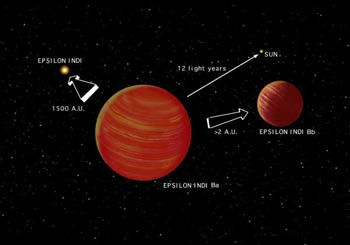Epsilon Indi

Epsilon Indi and its brown dwarfs.
Epsilon Indi is one of the nearest stars to the Sun. Epsilon Indi is a dwarf K star, orange in color, somewhat cooler than the Sun, and with about one-seventh the solar luminosity; it lies in the constellation Indus. Epsilon Indi has the tenth largest proper motion of any known star. Because, relatively speaking, it is moving so quickly across the sky, in only a few thousand years it will have moved out of Indus and into the neighboring constellation Tucana (the Toucan).
| Epsilon Indi A data | |
|---|---|
| visual magnitude | 4.69 |
| absolute magnitude | 7.00 |
| spectral type | K5Ve |
| luminosity | 0.14 Lsun |
| mass | 0.77 Msun |
| radius | 0.76 Rsun |
| distance | 11.8 light-years |
The brown dwarfs of Epsilon Indi
Around Epsilon Indi, at an average distance of 1.46 astronomical units (220 million kilometers), orbits one of the nearest known brown dwarfs. Discovered in 2003, this brown dwarf, Epsilon Indi Ba, has a mass of 40 to 60 times the mass of Jupiter and a surface temperature of about 1,260 K. Shortly after its discovery, Epsilon Indi Ba was found to have an orbital companion of its own – a cooler, fainter brown dwarf known as Epsilon Indi Bb.
The projected separation as seen on the sky between Epsilon Indi and Indi Ba is approximately 1500 AU (one AU, or astronomical unit, is the average distance between the Earth and the Sun or about 93 million miles (150 million kilometers), and the distance between Epsilon Indi Ba and Epsilon Indi Bb is at least 2.2 AU. Epsilon Indi Ba and Bb are members of a recently discovered type of astronomical object – the "T" class brown dwarfs.


